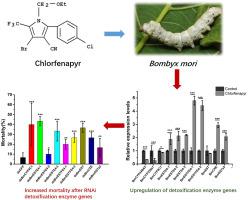Pesticide Biochemistry and Physiology ( IF 4.7 ) Pub Date : 2021-06-10 , DOI: 10.1016/j.pestbp.2021.104899 Ying Shao 1 , Xiang-Dong Xin 1 , Zhi-Xiang Liu 2 , Jiao Wang 2 , Ran Zhang 1 , Zhong-Zheng Gui 1

|
The silkworm, Bombyx mori (B. mori) is an important economic insect which ingests mulberry leaves and products the silk in industry. Chlorfenapyr is a new halogenated pyrrole insecticide which has been promoted for the control of mulberry insect pests in China. However, the detoxification mechanism of the silkworm to chlorfenapyr has not been investigated yet. In the present study, we first estimated the LC30 dose of chlorfenapyr for 3rd instar B. mori larvae, and then, in order to characterise the chlorfenapyr detoxification mechanism, the transcriptomes of chlorfenapyr-treated and untreated 3rd instar B. mori larvae were compared using RNA-sequencing. In total, 146, 533, 126 and 148, 957, 676 clean reads were obtained from insecticide-treated and control silkworm larvae, respectively, and these reads generated 10, 954 genes. The transcriptional profile of silkworm larvae was significantly influenced by chlorfenapyr treatment. A total of 1196 differentially expressed genes (DEGs) were identified in insecticide-treated and control B. mori larvae, in which 644 genes were upregulated and 552 genes were downregulated. Results showed that multiple DEGs were enriched in detoxication-related gene ontology (GO) terms and Kyoto Encyclopedia of Genes and Genomes (KEGG) pathways. Eleven detoxifying enzyme genes which differentially expressed were screened, and their expression patterns were validated by qRT-PCR. Furthermore, we successfully knocked down all differentially upregulated detoxifying enzyme genes, and a bioassay showed that the mortality of chlorfenapyr-treated silkworm larvae was significantly higher after silencing these genes than in groups injected with dsGFP. The present study reveals the molecular basis of silkworm detoxification to chlorfenapyr exposure, and provides new insights into the management of insecticide damage in the silkworm.


























 京公网安备 11010802027423号
京公网安备 11010802027423号